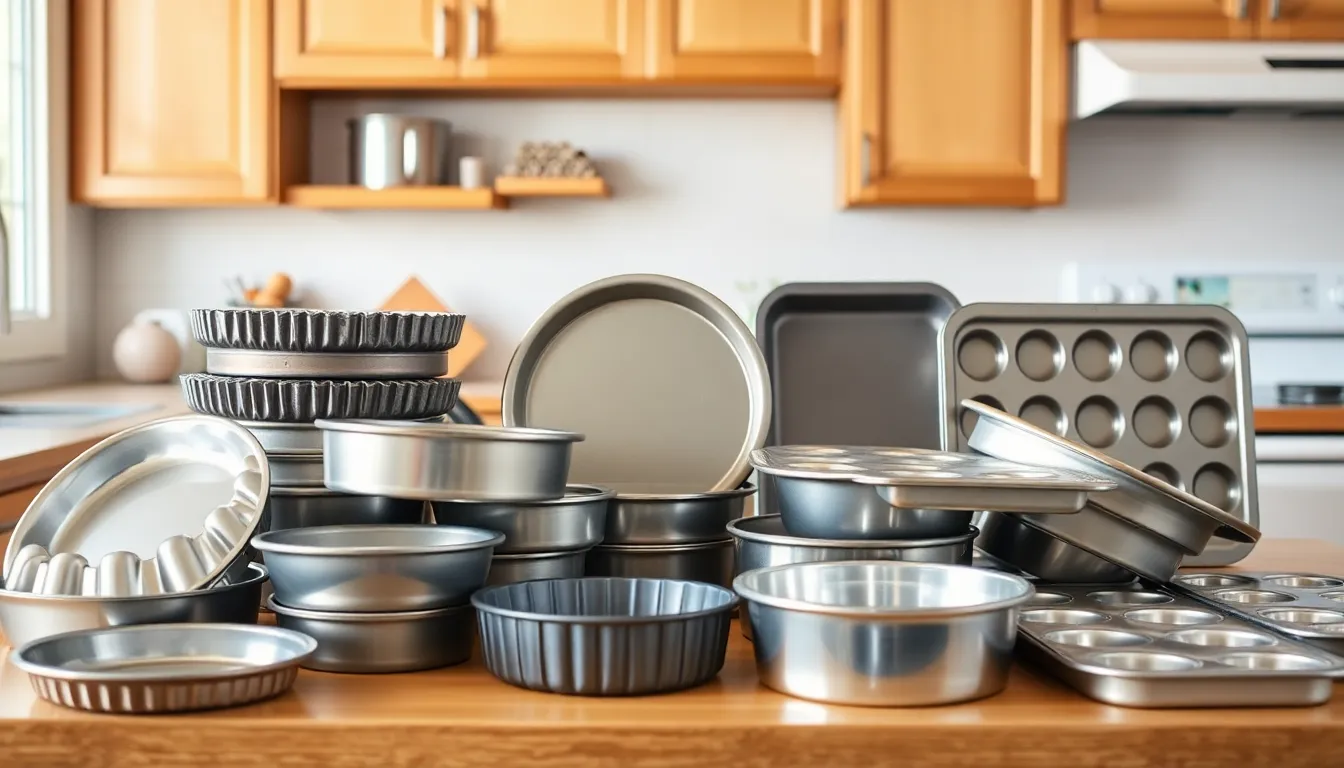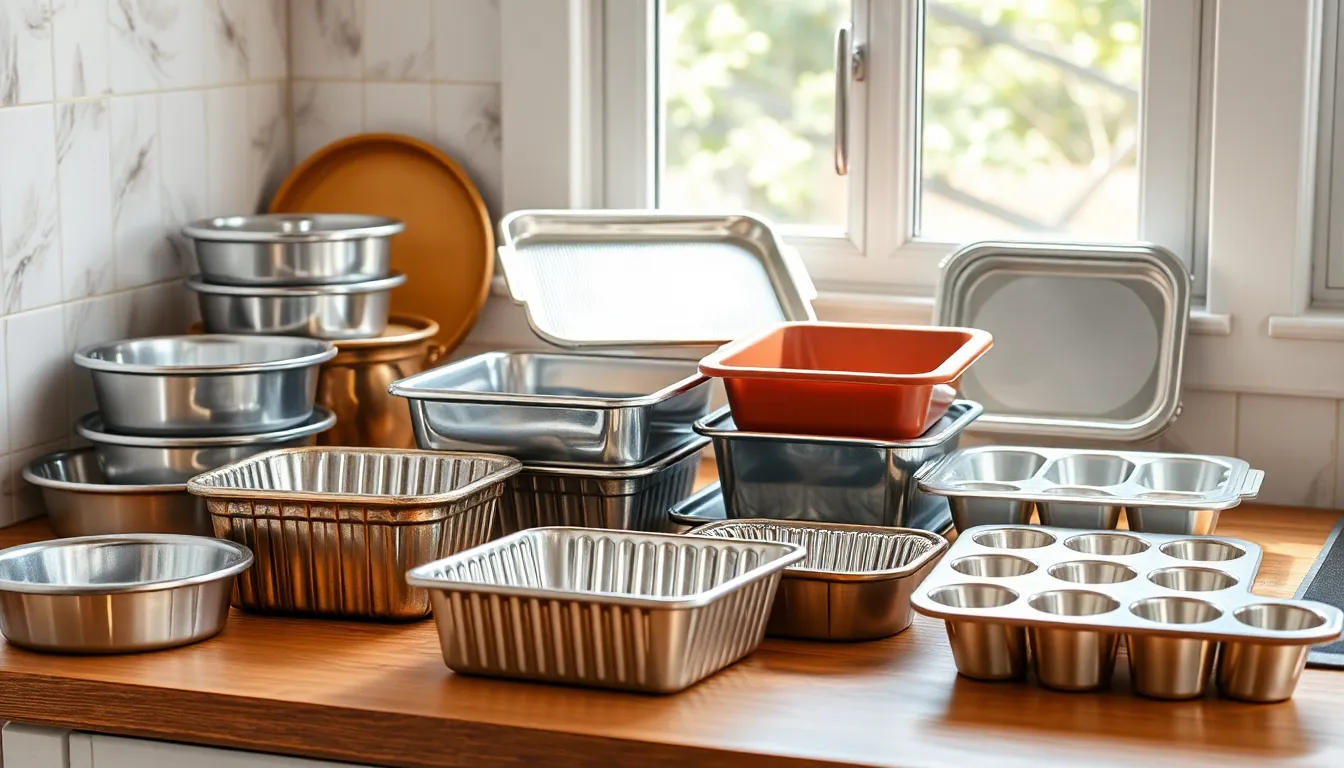The Best Fluffy Pancakes recipe you will fall in love with. Full of tips and tricks to help you make the best pancakes.

Baking Tins: Unlock the Secrets to Perfect Baked Goods Every Time
Baking tins might not be the most glamorous kitchen tool, but they’re the unsung heroes of every bake-off and birthday party. Imagine whipping up a decadent chocolate cake only to realize you’ve got nothing to bake it in—talk about a recipe for disaster! These trusty tins come in various shapes and sizes, ready to transform your batter into delicious masterpieces.
From classic round tins that hold the secrets to fluffy layers to whimsical shapes that spark joy, the right baking tin can elevate your culinary game. It’s time to stop treating your baking tins like the forgotten relatives of kitchenware. Embrace their power and let them work their magic. After all, who wouldn’t want their baked goods to rise to the occasion?
Baking Tins
Baking tins come in different types, each designed for specific baked goods. Understanding these types helps in selecting the right tin for successful baking.
Cake Tins
Cake tins vary in size and shape, including round, square, and rectangular options. Round cake tins, commonly used for layer cakes, create equal portions when sliced. Square tins often cater to brownies and bar cakes, providing uniform edges. Rectangular tins fit sheet cakes, perfect for parties or larger gatherings. Non-stick materials coat many cake tins, reducing the likelihood of sticking. A standard size for round tins typically measures 9 inches in diameter.
Muffin Tins
Muffin tins feature multiple cups designed for individual servings. Commonly, a muffin tin holds 12 cups, ideal for batches of standard-sized muffins. Options include non-stick variants, silicone, and metal. Silicone muffin tins simplify the removal of baked goods, eliminating the need for greasing. Mini muffin tins, smaller in size, allow for bite-sized portions; they cater well to parties and gatherings. Each cup generally measures about 2.5 inches in diameter.
Loaf Tins
Loaf tins typically create bread or loaf-style cakes. Standard loaf tins measure approximately 9 by 5 inches, perfect for most baked bread recipes. Non-stick surfaces help ensure an easy release of baked goods. Some variations include mini loaf tins, which yield smaller loaves suitable for gifting or personal servings. Obtaining a good crust requires proper greasing and preheating the oven before use. These tins also support baking meatloaf and terrines.
Cookie Sheets
Cookie sheets serve as flat baking surfaces for cookies and pastry items. Common sizes include half-sheet and full-sheet options, with half-sheets measuring about 18 by 13 inches. Non-stick sheets aid in easy cleanup and prevent cookies from sticking. Raised edges are present on some cookie sheets, called jelly roll pans, allowing for different baking methods. Parchment paper often lines sheets to provide an additional non-stick layer. Baking in batches commonly involves using multiple cookie sheets for efficiency.
Choosing The Right Baking Tins

Selecting the appropriate baking tin influences the outcome of baked goods significantly. Understanding diverse materials and dimensions simplifies this choice.
Material Considerations
Aluminum tins distribute heat evenly, promoting uniform browning. Stainless steel offers durability and is non-reactive, making it suitable for acidic ingredients. Silicone provides flexibility, allowing easy release of baked items but may require more careful handling. Additionally, ceramic tins retain heat well, ensuring thorough cooking. Each material’s characteristics contribute to distinct baking results, ensuring optimal performance.
Size And Shape Importance
Baking tins come in various sizes and shapes, impacting the baked product’s presentation and cooking time. Round tins suit layered cakes, while square and rectangular tins often work for brownies and bars. Loaf tins deliver consistent results for bread, and muffin tins offer individual portions. Selecting the right size ensures even baking and proper rising for preferred recipes.
Non-Stick Vs. Traditional
Non-stick tins simplify the baking process by preventing food from adhering to the surface. These options usually require less greasing, reducing preparation time. Traditional metal tins, however, offer durability and reliability, with many bakers preferring them for certain recipes. Each type has its own merits, influencing choice based on specific baking needs and preferences.
Maintenance And Care For Baking Tins
Maintaining and caring for baking tins ensures their longevity and performance. Proper care enhances baking results and simplifies clean-up processes.
Cleaning Tips
Start with gentle cleaning solutions, as harsh chemicals can damage tin coatings. Use warm, soapy water along with a soft sponge to clean non-stick surfaces. Avoid using metal utensils, as they can scratch the finish. Tackle stubborn residue by soaking the tin in warm water before scrubbing. Rinse with clean water to remove soap completely. When handling silicone tins, hand washing is recommended to preserve their flexibility. Dry thoroughly before storing to prevent moisture buildup.
Storing Your Tins
Store baking tins in a dry, cool location to avoid rusting or warping. Nest smaller tins inside larger ones to save space while protecting their surfaces. Separate silicone tins from metal tins to prevent potential damage. Use dividers or soft cloths to minimize scratches between stacked tins. Ensure lids remain loose on containers to allow for air circulation. Regularly check for wear and tear to maintain quality and function.
Popular Brands Of Baking Tins
Numerous brands provide high-quality baking tins, offering choices for every baker.
Quality Options
Brands like USA Pan and Fat Daddio’s stand out for their exceptional durability and performance. USA Pan uses heavy-duty aluminized steel, ensuring even heat distribution for consistent baking results. Fat Daddio’s opts for anodized aluminum, providing a sleek surface that prevents sticking. Nordic Ware, known for its iconic Bundt pans, employs a non-stick coating and heavy-gauge construction for reliability. Another top choice, Emile Henry, offers ceramic baking dishes that excel in heat retention, making it ideal for various baked goods. These premium options cater to serious bakers prioritizing quality over cost.
Budget-Friendly Choices
Bakers on a budget can explore brands like Wilton and Amazon Basics for reliable yet affordable baking tins. Wilton offers a comprehensive line of non-stick and metal pans, ensuring accessibility without compromising essential features. Amazon Basics, similarly, provides a range of basic bakeware at a competitive price, suitable for novice bakers. Similarly, Pyrex baking dishes feature glass construction, allowing for versatility in both baking and serving. These options affirm that quality baking tins can be acquired without high expenses, making baking accessible to everyone.
Conclusion
Baking tins are vital for anyone looking to elevate their baking game. With the right selection of shapes and materials, bakers can achieve better results and create stunning presentations. Proper care and maintenance of these tools ensure they last for years, making them a worthwhile investment in any kitchen.
As bakers explore various brands and options, they’ll find that quality baking tins can significantly impact their culinary creations. Whether opting for non-stick convenience or traditional reliability, understanding the nuances of baking tins can lead to more enjoyable and successful baking experiences.
